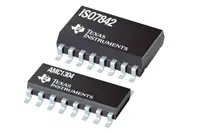Electronics News
Archive : 13 November 2014 год
 Seven months after announcing their Newton platform, Chinese fabless semiconductor company Ingenic is following up with Newton2; a MIPS based solution aimed at lowering the power consumption and area size of next generation wearables.
Seven months after announcing their Newton platform, Chinese fabless semiconductor company Ingenic is following up with Newton2; a MIPS based solution aimed at lowering the power consumption and area size of next generation wearables.
The hardware module measures 15 x 30mm – 50% smaller than its predecessor. It packs an Ingenic M200 dual core XBurst processor, eMCP memory, smart power management controller, on-board Wi-Fi and Bluetooth connectivity and a MEMS sensor, together with seven dedicated connectors for the usual interfaces (display, audio, camera etc.)
Battery life has also been improved significantly (standby power consumption for Newton2 is less than 3mW, allowing devices to work for twice as long).
Target applications include smart watches, augmented reality headsets, smart glasses, wearable healthcare monitors, fitness bands, sleep sensors, activity trackers and smart clothing.
The board runs the latest version of the Android and Linux operating systems. A MIPS CPU clocked at 1.2GHz tackles most of the heavy lifting, while less demanding tasks are handled by a secondary low power 300MHz MIPS CPU.
When in full operating mode, the M200 chip consumes only 150mW. Ingenic's engineers were able to achieve this performance by redesigning all of the key modules inside the SoC to target ultra low power operation.
Additionally, the M200 integrates special fabric that creates multiple low power modes of operation and distinct power islands. These islands can also be switched on by special programmable triggers (e.g. voice activation).
Finally, the chipset also includes an ISP for image pre-processing that supports a range of features for camera vision applications.
Author
Laura Hopperton
Source: www.newelectronics.co.uk
 Expanding its line up of image recognition processors, Toshiba has announced the TMPV760, targeted at advanced driver assistance systems (ADAS).
Expanding its line up of image recognition processors, Toshiba has announced the TMPV760, targeted at advanced driver assistance systems (ADAS).
Supported by 14 hardware based image recognition accelerators, the device supports standard ADAS systems, including autonomous emergency braking, traffic light recognition, lane departure warning, lane keeping assist, high beam assistance and forward collision warning.
It also supports a number of new applications that will become part of the Euro NCAP testing programme in 2018.
The TMPV7608XBG integrates two new enhanced CoHOG accelerators that provide high image recognition accuracy, especially in low light and night time conditions.
Toshiba claims the device greatly improves night time pedestrian detection rates using colour based gradient analysis of images supplied by Full HD connected cameras.
In addition, the TMPV7608XBG supports a SfM (Structure from Motion) accelerator that detects objects not part of a pre-defined library.
The processor can handle multiple applications simultaneously in real time using its heterogeneous multi core architecture. It features newly integrated image processing accelerators and eight MPEs supported by FPUs that perform double precision floating point arithmetic calculations.
The chip is housed in a P-FBGA 796 ball package measuring 27 x 27mm. Ball pitch is 0.8mm.
Author
Laura Hopperton
Source: www.newelectronics.co.uk
 IQD's newest addition to its range of advanced oscillator modules is its IQCM-110 series of GPS disciplined OCXOs.
IQD's newest addition to its range of advanced oscillator modules is its IQCM-110 series of GPS disciplined OCXOs.
Unveiled at electronica this week, the new design incorporates an internal GPS receiver with a 1PPS output and is housed in a 14pin 60mm square package.
When coupled to an external aerial via the incorporated SMA connector, in the event of the loss of the GPS signal, the 10MHz OCXO will switch-in with a holdover capability of 1.5 µSeconds for a 24 hour period, thereby maintaining lock until restoration of the reference signal.
The standard operating temperature range of the module is -20 to 75 °C, although other temperature ranges and holdover specifications can be considered on request.
The required power supply is 5V with the output being standard HCMOS. Current consumption is 2A maximum during warm up with this reducing to 1A once the steady-state condition is reached.
Full details are available from IQD on Stand 314 in Hall B5.
Author
Laura Hopperton
Source: www.newelectronics.co.uk
 In his keynote address to NIDays, held last week in London, Eric Starkloff, vice president of global sales and marketing for National Instruments, said the Internet of Things (IoT) was not so much a technology, but more a 'convergence of technology'. He identified four main contributors: Moore's Law; wireless connectivity; sensor technology; and networking.
In his keynote address to NIDays, held last week in London, Eric Starkloff, vice president of global sales and marketing for National Instruments, said the Internet of Things (IoT) was not so much a technology, but more a 'convergence of technology'. He identified four main contributors: Moore's Law; wireless connectivity; sensor technology; and networking.
Applications, Starkloff continued, could be split into two main areas: industrial, including smart factories, smart machines and smart cities; and consumer, such as wearables, smart TVs and smart homes.
He then went on to talk about the test solutions needed to make the IoT a a reality, before handing over the stage to Ian Bell, NI's engineering group leader, who introduced delegates to the world's first reconfigurable oscilloscope.
"When we set out to design this new oscilloscope, we wanted to start from the ground up," Bell noted. "Most oscilloscopes on the market today work like products common in the 1980s. They take snapshots of a signal and post process the data to find specific trigger conditions. During the 'dead times' between snapshots, the oscilloscope can miss triggers, making it more difficult to find problems in your design and resulting in longer test times.
"In our new oscilloscope we take a different approach; the FPGA is in the digital data path right behind the A/D converter, processing every data point continuously."
Another hot topic which NI was keen to discuss at the event was skills. The company's academic director Dave Wilson told delegates about NI's efforts to make sure graduates are ready for the workplace. "Skills learned in the classroom, paired with platforms that scale to industry, are what will prepare students to solve the grand challenges of tomorrow," he stressed.
Also tackling the subject of skills and grand challenges was NI's technical marketing manager Richard Roberts, who used the last keynote of the day to talk about issues such as healthcare, sustainability, urban infrastructure and security. Roberts said it was 'critical' to prepare the next generation of innovators if feats like engineering better medicine, providing energy from fusion and reverse engineering the human brain are ever to be achieved.
Author
Laura Hopperton
Source: www.newelectronics.co.uk
 Spansion has licensed ARM's Cortex-M7 processor for its new range of next generation MCUs and system solutions.
Spansion has licensed ARM's Cortex-M7 processor for its new range of next generation MCUs and system solutions.
"The new ARM Cortex-M7 processor will deliver advanced intelligence and energy efficiency for embedded applications," said Dhiraj Handa, senior vice president and general manager of Spansion's multi-market microcontroller susiness. "We look forward to introducing innovative MCUs with the Cortex-M7 core. These new devices will address our customer requirements in emerging applications for the industrial, consumer, IoT and wireless connectivity markets."
Richard York, vice president of embedded marketing at ARM, added: "With double the compute and DSP capability of the previous ARM Cortex-M processor, the Cortex-M7 is purpose built for high end embedded applications. We fully expect to see Spansion capitalising on the core's features to create unique and exciting new MCUs for their customers."
Author
Laura Hopperton
Source: www.newelectronics.co.uk
.webp) Tektronix has introduced a physical layer transmitter characterisation and debug solution for the MIPI M-PHY v3.1 specification.
Tektronix has introduced a physical layer transmitter characterisation and debug solution for the MIPI M-PHY v3.1 specification.
The MSO/DPO70000DX oscilloscopes and P7600 TriMode probes include support for MIPI M-PHY High Speed Gears 1, 2 and 3, PWM Mode (G0-G7), and SYS Mode.
They are claimed to offer the lowest noise performance in the industry, as well as 10x higher sensitivty than competing solutions.
Brian Reich, general manager of performance oscilloscopes, Tektronix, said: "We're seeing a growing emphasis on performance in mobile device design, meaning that more and more designs are incorporating MIPI M-PHY Gear 3 to operate at the highest data rate possible under the MIPI M-PHY specifications.
"This in turn has introduced new signal acquisition challenges due to the combination of low amplitude signals and high speeds. Tektronix probing solutions are significantly ahead of the industry and fully meet MIPI M-PHY v3.1 requirements."
Author
Laura Hopperton
Source: www.newelectronics.co.uk
 Texas Instruments' new data converter and digital isolation families are designed to enable leading reinforced isolation ratings and precision performance for high voltage applications.
Texas Instruments' new data converter and digital isolation families are designed to enable leading reinforced isolation ratings and precision performance for high voltage applications.
The ISO7842 series of high immunity reinforced isolators can withstand an isolation barrier with a working breakdown voltage of 1,500Vrms for a minimum lifetime of 40 years.
The AMC1304 delta-sigma modulator family is said to offer best in class precision performance and the lowest power consumption with reinforced isolation for current shunt monitoring.
The devices offer robust, high speed reinforced isolation to meet critical functional and safety isolation requirements for applications exposed to potential high voltage breakdowns.
They are also optimised to provide precision analogue performance and high immunity for noisy industrial environments.
Author
Laura Hopperton
Source: www.newelectronics.co.uk
 UK manufacturer Plessey has developed a large LED die based on its GaN-on-Silicon technology.
UK manufacturer Plessey has developed a large LED die based on its GaN-on-Silicon technology.
Produced as a technology demonstrator, the die benefits from three core features: low thermal resistance, a single surface, emitter die design and 6in wafer processing.
In addition, it utilises Plessey's vertical design structure, which has a cathode top and anode bottom contacts.
To exploit these benefits, Plessey has produced a 20mm2 die design that can generate up to 5W of blue light over a 400 to 480nm wavelength range.
David Owen, Plessey's marketing director, commented: "It is clear that the next wave of general lighting products will see LEDs applied in ways that truly exploit the benefits obtained through Plessey's leading GaN-on-Si technology.
"This announcement marks the start of a phase where we engage with our key partner customers in defining the commercial realisation of lighting products based on Plessey's large GaN-on-Silicon LED die."
Author
Laura Hopperton
Source: www.newelectronics.co.uk
 A next generation, wireless electroencephalography (EEG) headset has been unveiled by imec and Holst Centre.
A next generation, wireless electroencephalography (EEG) headset has been unveiled by imec and Holst Centre.
The device combines dry electrodes with integrated skin-to-electrode impedance monitoring to provide information about the contact quality throughout the entire EEG recording. Signal processing is integrated to cancel out motion artefacts.
What's more, a motion artifact handling approach was developed for the device, based on band-pass and adaptive filtering, which is said to substantially reduce the contamination of the EEG recordings due to motion and it can operate in real-time.
While EEG measurements are typically performed by trained professionals in hospitals, with this headset imec says wireless EEG monitoring could soon be carried out reliably in the home.
Author
Laura Hopperton
Source: www.newelectronics.co.uk
 Visitors to the Tektronix stand at electronica will be able to get hands on with the world's first six-in-one oscilloscope.
Visitors to the Tektronix stand at electronica will be able to get hands on with the world's first six-in-one oscilloscope.
By combining six functions into the MDO3000, the company says it has integrated most of a designer's workbench needs into one instrument.
Its research found that more than 25% of oscilloscope users also used a spectrum analyser several times a week, hence the decision to develop the first oscilloscope with integrated spectrum analyser. Along with a scope, the device includes a spectrum analyser, logic analyser, protocol analyser, arbitrary function generator and digital voltmeter.
To minimise initial outlay, the MDO3000 can be purchased with the latter four functions locked. These can be accessed at a later date if needed.
Visit the company in Hall A1, Stand 668 to find out more.
Author
Laura Hopperton
Source: www.newelectronics.co.uk
